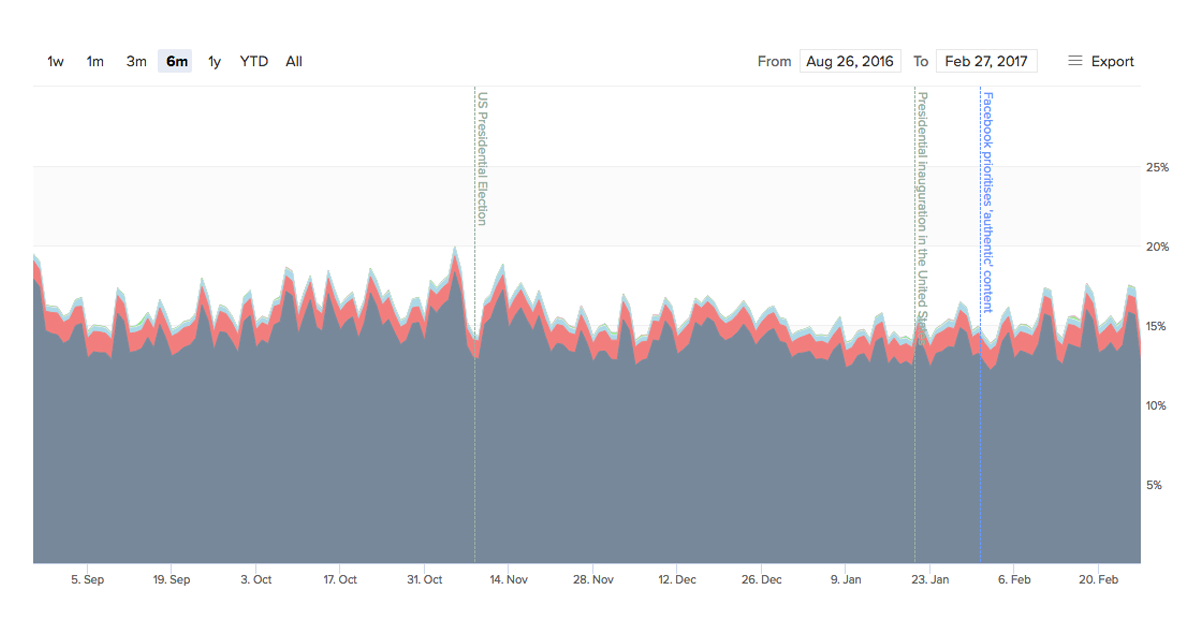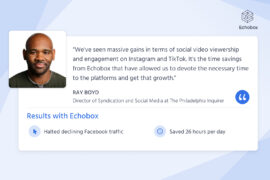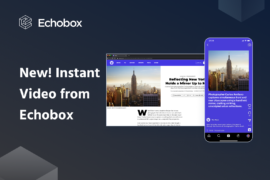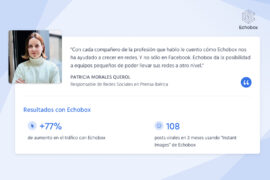Only a few years ago, Facebook dominated the social media landscape. Fast forward to 2020 and while Facebook remains the most used by far, the landscape has become far more diverse, with Instagram and messaging apps rising in popularity. Today, 36% of people use Instagram, up from just 8% in 2014.
Facebook persists as the staple of most publishers’ social media strategy, but many are also tapping into the potential of Instagram. Though Facebook-owned, Instagram offers a distinctly different experience centered on visual appeal. Instagram is therefore an ideal platform for publishers to showcase their creativity and engage new audiences with image-led storytelling.
In this article, we highlight how 3 leading publishers and Echobox customers are using Facebook and Instagram in a complementary way to engage followers and expand reach. We’ll also take a closer look to understand how Instagram and Facebook compare in terms of popularity, audience and traffic.
- 1. How publishers are using Facebook and Instagram together
- Newsweek delivers key headlines on Instagram with strong brand style
- Case study: Newsweek doubles Facebook traffic with Echobox
- The Telegraph opts for an eclectic mix of visuals on Instagram
- Case study: The Telegraph drives digital subscriptions and boosts engagement by 205%
- The Times attracts audiences with its selection of striking photojournalism
- 2. Instagram audiences vs Facebook audiences: how do they compare?
- 3. Publisher traffic from Instagram vs Facebook
- How much traffic do publishers see from Facebook compared to Instagram?
- Read more: How COVID-19 changed the news in less than 30 days
- How have traffic levels changed over time for Instagram vs Facebook?
- Check out the world’s first Social Media Index
- When does Facebook drive traffic to publishers? When does Instagram drive traffic?
- Read more: When is the best time to post on Facebook?
- Read more: When is the best time to post on Instagram?
- 4. Find the sweet spot for Instagram and Facebook posts
1. How publishers are using Facebook and Instagram together
Facebook continues to be the core of publishers’ social media strategy, but many have widened their scope to include Instagram in a significant way. For Newsweek, The Times and The Telegraph (who all use Echobox to optimize their posting across social platforms), Instagram plays a vital role in growing social reach and engaging new audiences. Let’s take a look at their approach on Instagram versus Facebook to see how news content on both platforms can be complementary.
Newsweek delivers key headlines on Instagram with strong brand style
On Facebook, Newsweek currently counts nearly 1.4 million followers. Posting frequently throughout the day, Newsweek uses its Facebook page to share the freshest news around the clock.
On Instagram, Newsweek currently counts 88.6K followers. Every day, Newsweek posts a much smaller selection of the news items shared on its Facebook page, sometimes focusing on just one or two Instagram posts featuring key news stories. The group also experiments with Instagram Stories that engage followers with a quiz-like format and deliver bite-size information.
Newsweek’s visual style on Instagram combines eye-catching headlines and photos from the day’s news. To add some variety in style while remaining close to the Newsweek brand, headlines vary between black text on a white background, and white text on a red background. Newsweek’s Instagram images are almost always accompanied by an explanatory header, except when the post features the cover of Newsweek’s print issue for that week.


The Telegraph opts for an eclectic mix of visuals on Instagram
On Facebook, The Telegraph currently counts nearly 4.5 million followers. Like Newsweek and other news publishers, The Telegraph delivers a steady stream of news on Facebook around the clock.
On Instagram, The Telegraph currently counts 730k followers and shares a handful of Instagram posts each day featuring a juxtaposition of visual styles (photos, illustrations, quotes, photomontages).
In some cases, The Telegraph cross-features the same news story on both Facebook and Instagram, but with different packaging and presentation of the post. In the examples below, the stories were published on The Telegraph’s Facebook page using a news photo; they were published on The Telegraph’s Instagram account with an illustration featuring an attention-grabbing headline overlay:


The Times attracts audiences with its selection of striking photojournalism
On Facebook, The Times and The Sunday Times currently counts 823K followers and offers extensive news coverage all day long. The publisher also shares a significant amount of engaging video content on Facebook Watch, notably its “Times Q&A” video series which aims to “tackle the big questions.”
On Instagram, The Times currently counts 658K followers, and it’s worth noting that of the 3 publisher examples highlighted here, The Times has the smallest gap in size between its Instagram audience versus its Facebook audience. The Times’ Instagram account features a handful of striking images curated by its photo desk each day, as well as political cartoons posted almost daily. The majority of content featured on The Times’ Instagram account is distinct from the news stories covered on its Facebook account, though in some cases the same news items are posted to both platforms with different types of images:

In contrast to Newsweek’s approach above, for example, The Times’ Instagram posts do not feature headlines or text overlays – they rely on the power of the curated images to capture audience attention and incite people to learn more.
2. Instagram audiences vs Facebook audiences: how do they compare?
Many people use both Instagram and Facebook, and there is undeniably some audience overlap between the two. Yet on a global scale, certain differences in Instagram users versus Facebook users are still visible.
Who has more global users, Instagram or Facebook?
In terms of sheer audience size, Facebook is the leader: on any given day, there are 3 times more people using Facebook compared to Instagram – 1.66 billion people use Facebook, while more than 500 million people use Instagram.
In what countries are Facebook and Instagram most popular?
Comparing the countries with the most users on each platform, we see that India, the United States, Indonesia and Brazil are all important nations for both Facebook and Instagram. The United States is home to the most Instagram users, followed by India. For Facebook, the inverse is true – India takes the far lead in number of users, followed by the United States:
Top 5 countries with most Facebook users:
| Country | Number of Facebook users |
|---|---|
| India | 290M |
| United States | 190M |
| Indonesia | 140M |
| Brazil | 130M |
| Mexico | 89M |
Top 5 countries with most Instagram users:
| Country | Number of Instagram users |
|---|---|
| United States | 130M |
| India | 100M |
| Brazil | 91M |
| Indonesia | 73M |
| Russia | 51M |
How old are Instagram users vs Facebook users?
Looking at younger audience segments (users under 25), we see that Instagram skews slightly younger than Facebook:
- 30% of Facebook users are under 25 years old
- 36% of Instagram users are under 25 years old
But despite a rise in older Facebook users in recent years (leading some to even coin it “social media’s retirement home”), data shows that on both Instagram and Facebook, the majority of users are still under 35:
- 62% of Facebook users are under 35 years old
- 70% of Instagram users are under 35 years old
All user age data from DataReportal
Do people spend more time on Instagram or Facebook?
One rising trend is the shift in time spent on each platform. A recent Reuters report notes that in many Western countries, users are spending more time on Instagram and less time on Facebook.
This trend is further pronounced when looking at under 35s in particular: Reuters analyzed the proportion of under 35s who report spending more time or less time on each platform:
- +25% of under 35s said they spend more time on Instagram
- just +1% of under 35s said they spend more time on Facebook
So while younger people are spending about the same amount of time on Facebook compared to last year, many are now investing more time in Instagram – a trend to watch over the next few years.

3. Publisher traffic from Instagram vs Facebook
Facebook has a much more massive user base than Instagram, but many of these users (especially the youth) are spending more of their time on Instagram. How do these differences translate into social media traffic patterns for publishers?
To find out, we used data from the Social Media Index, which shows how much traffic the online publishing industry receives each day from all major social media platforms, including Facebook and Instagram.
How much traffic do publishers see from Facebook compared to Instagram?
Facebook remains the dominant source of social media traffic to publisher sites.
In 2019, Facebook drove on average 11.3% of all traffic to publishers’ websites. That share of traffic grew this year – so far in 2020, Facebook has driven 13.4% on average of all traffic to publishers’ websites.
Looking at the data for the first half of 2020, we see that Facebook drove the largest amount of traffic to publishers’ websites on Sunday 14 June (16.93% of all traffic), and drove the lowest amount of traffic on Monday 16 March (10.99%), both indicated by arrows on the graph below. This dip was followed by relatively higher levels throughout the rest of March, possibly related to elevated coronavirus-related traffic, and a slight but steady upward trend through to today. As of July 2020, the share of Facebook traffic hovers around 15%, meaning one in seven pageviews accrued by news publishers today comes from Facebook.

Share of Facebook traffic 2020 year-to-date:

How does Instagram traffic compare to Facebook traffic levels?
Predictably, Instagram drives far less traffic to publisher websites than Facebook: it’s responsible for a scant 0.25% of all traffic to publishers’ websites in 2020 thus far – a slight decrease from 2019, when Instagram drove 0.30% on average of all traffic to publishers’ websites.
This is unsurprising, as Instagram posts do not contain clickable links, and “swipe up” links on Instagram Stories are only available to publishers with 10,000 followers or a verified account. Instagram is designed to foster engagement between brands and user communities natively on the platform. It’s therefore much less efficient at driving traffic through to a publisher’s website than Facebook, and our traffic data clearly reflects this.
A visual comparison instantly confirms this disparity, revealing how massive Facebook’s portion of traffic is compared to Instagram (represented here by the pink line, barely visible at certain points):
Instagram vs Facebook share of traffic 2020 year-to-date:

So far in 2020, Instagram drove the largest amount of traffic to publishers’ websites on Tuesday 18 February, though at just 0.62%, this “peak” was still minuscule compared to traffic leader Facebook. Instagram traffic declined during the second half of March (circled in red on the graph below). This corresponded to an elevated share of Facebook traffic during the same period (as shown above), suggesting that increased social traffic from Facebook may have cannibalized Instagram’s typical contribution to publisher traffic – however minimal – during this time.
Share of Instagram traffic 2020 year-to-date:

Instagram traffic has still not returned to the same levels seen at the start of 2020. Nonetheless, it’s important to remember we’re talking about just a fraction of a percent, so the variations we observe here would not likely have a noticeable impact on publishers.
How have traffic levels changed over time for Instagram vs Facebook?
Over the past 3+ years, the share of Facebook traffic to publisher websites has not remained constant over time. It declined throughout 2017, and then began a slow ascent in summer 2018 to reach levels in early 2020 that we hadn’t previously seen since 2017:
Instagram vs Facebook share of traffic 2017-2020 to date:

When we isolate Instagram traffic out from Facebook, we see a slightly different story of how Instagram traffic to publisher websites has changed over time:

The share of traffic to publisher websites from Instagram has multiplied over the last few years, with traffic share starting to steadily rise throughout 2017 and 2018 before dropping significantly in March of this year, as we observed in closer detail above.
Though Facebook sends exponentially higher levels of traffic to publishers’ websites, it’s worth watching this Instagram traffic trend. As cited above, Instagram usage is increasing, and not only that – a growing number of people worldwide use Instagram for news in particular. As leading publishers place a greater focus on Instagram strategy, it will be critical to understand how Instagram contributes to publisher traffic over time.

When does Facebook drive traffic to publishers? When does Instagram drive traffic?
Facebook traffic peaks on the weekends, while Instagram traffic peaks mid-week.
There are recurring spikes in Facebook and Instagram traffic to publishers’ websites, and they’re as regular as clockwork. Facebook drives the most traffic on the weekends: on average, Facebook is 6% more important as a traffic source on Saturdays and 5.5% more important on Sundays than during the rest of the week. (This trend does not apply to all publishers though.)

The opposite is true for Instagram, whose traffic intensifies mid-week and peaks on Tuesday. On Sundays, Instagram is nearly 8% less important as a source of traffic than it is during the rest of the week:
Change in share of traffic from Facebook vs Instagram by day of week:

What are the reasons for this weekend drop-off in Instagram traffic? There are likely multiple factors at play, which would require deeper analysis to identify. These traffic patterns serve as a reminder that audiences are different on Instagram versus Facebook, each with their own content consumption and engagement behaviors.
Even if a person follows a publication on both Facebook and Instagram, they may expect a different brand experience on each platform. For example, they might prefer to stay informed of breaking news via Facebook and therefore engage more with hard news posts on this platform while consuming entertainment or feature-type stories more often on Instagram. The key is understanding your audiences’ unique behaviors and preferences and optimizing your social media publishing accordingly.

4. Find the sweet spot for Instagram and Facebook posts
When comparing Facebook and Instagram, it’s important to remember that the two platforms are fundamentally different. Facebook boasts a larger audience, enabling publishers to extend the reach of their content and drive referral traffic back to their websites. Instagram lets publishers experiment with new storytelling formats, engage new audience segments, and build a community of followers directly on the Instagram platform. Each platform therefore has its own key role to play within a publisher’s social media strategy.
For this reason, it’s vital for publishers to establish tailored posting strategies for their Facebook pages and Instagram accounts. An effective way to achieve this is using artificial intelligence that can understand distinct audience behaviors on both Facebook and Instagram, and optimize publisher reach and engagement on both platforms. Echobox achieves this for publishers by predicting post virality, calculating optimal share times and frequencies, and automating social media sharing in part or in full, across Facebook, Instagram, Twitter and LinkedIn. As a result, publishers who use Echobox see their traffic increase by an average of 36% – download the Echobox Social Factsheet to learn more.
Want this article in PDF? Download it here
“There’s no question about the benefit. We’re now big believers in the Echobox AI.”
Adam Silvers, Deputy US News Director and Senior Digital Strategist, Newsweek



